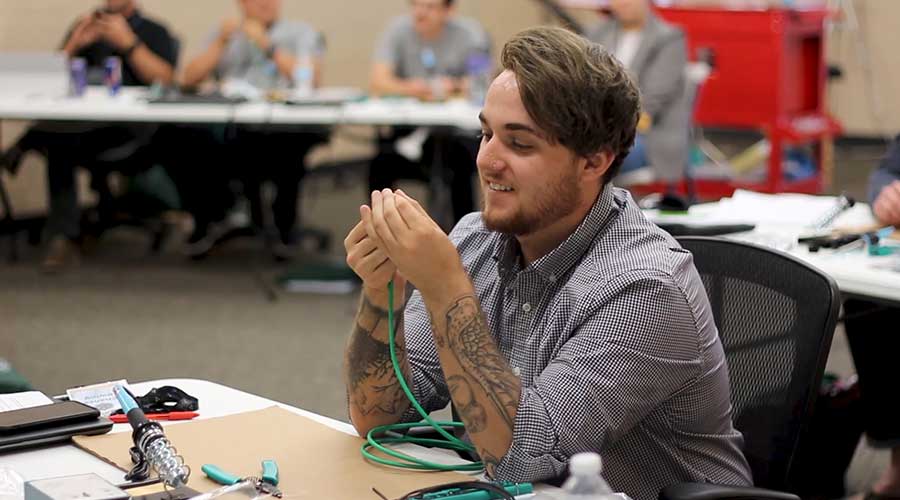Every prank-loving adolescent knows all it takes is a little corn syrup and food coloring to whip up a batch of fake blood that will scare the pants off an unsuspecting mom, sibling or neighborhood friend. But recreating realistic wounds and injuries isn’t just for April Fools’ Day or Halloween. Special effects make up—or moulage—can also be an effective and affordable way to create realistic medical simulation scenarios that enhance and improve the learning experience.
on Monday, 22 April 2019.
Posted in Medical Simulation Training, Simulation Training
We, at Level 3 Audiovisual have the opportunity to work with some world-class educators in various pedagogical disciplines in our pursuit to provide next generation technology solutions for higher education organizations. Several of these organizations are leading the learning technology evolution and changing the way they approach classroom technology configurations.
on Wednesday, 17 April 2019.
Posted in Classroom Technology, Hybrid Classroom
So, you’re designing an academic simulation center. You probably have a pretty good idea of the kinds of spaces you need—somewhere to run simulations and somewhere to debrief them, for example—but what about the technology each of those spaces require to run smoothly and deliver results for learners? If digging through your technology requirements and trying to choose the best solution gives you the anxiety sweats, grab your anti-perspirant and keep reading. Level 3 has successfully designed and deployed large-scale, integrated academic solution centers. Based on that experience, here are four spaces that are critical to your simulation center’s success, and the technology solutions they need to run smoothly.
on Tuesday, 26 March 2019.
Posted in Healthcare Simulation, Medical Simulation
PSNI GLOBAL ALLIANCE MEMBERS RECOGNIZED IN 4TH ANNUAL EMPLOYEE ENGAGEMENT SURVEY
PSNI Global Alliance, the largest network of audiovisual integrators and service providers in the world is pleased to award Viewhaus Sistemas, located in Guadalajara, Mexico and Level 3 Audiovisual, headquartered in Mesa, Arizona, the “Best Places to Work in AV” award for 2018. This award recognizes members of PSNI Global Alliance who exceed key employee-performance metrics identified by the PSNI-exclusive Employee Engagement Survey.
on Tuesday, 19 March 2019.
Posted in Award Winning
Does your list of responsibilities seem to grow every day? Every organization’s simulation program is a little different and without an industry-wide standard for the role of simulation technician or operations manager, deciding what knowledge, skills, and abilities are most important can be a little daunting. The simulation experts at Level 3 Audiovisual recently weighed in on this topic during the webinar, “10 Things Your Sim Tech Should Know” but—spoiler alert—there are four critical skills every sim tech should have.
on Monday, 18 March 2019.
Posted in Medical Simulation Training, Simulation Training
It’s easy to think that something is better just because it’s more expensive. And if you are comparing, say, a Kia to a Lamborghini, that might be true. But in a lot of cases, it isn’t. In fact, the cheap seats at the ballpark usually have the best view. When it comes to audiovisual solutions, expensive doesn’t always mean better either. As you are designing new AV systems, understanding what you should spend your money on—and where you can cut corners—can ensure you get the functionality you need without exceeding your budget.
on Tuesday, 12 March 2019.
Posted in Audio-Video Installation, AV Design
March 6, 2019 7:00 AM Mountain Standard Time
Level 3 Audio Visual, LLC, a full-service AV integration and education organization located in Mesa, Arizona announces today the acquisition of Audio Visual Resources, Inc. (AVR) located in Mineola, NY. The acquisition combines one of the nation’s top integration firms with the industry leader in system testing and verification, and the only firm ever to have achieved both ISO 9000 and AV-9000 Certifications.
on Wednesday, 06 March 2019.
Posted in Level3 Audiovisual
ARE YOU A SIMULATION TECHNICIAN? THIS TRAINING IS FOR YOU
Your organization might be ready to shell out the money for a new or expanded healthcare simulation lab, but are you, the simulation technician, fully prepared to operate and manage it? Don’t fret if the answer is no, or maybe, or I don’t know. Level 3 Audiovisual's Simulation Boot Camp will teach you everything you need to know to succeed in your sim tech role, as well as help your organization’s simulation program succeed.
on Monday, 25 February 2019.
Posted in Medical Simulation Training, Simulation Training
 How to Create Realistic Moulage and Why It Matters
How to Create Realistic Moulage and Why It Matters 







